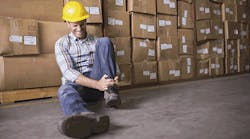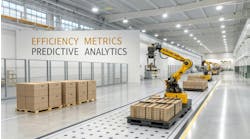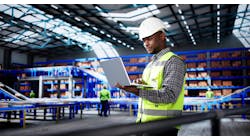It's no secret that 32% of the 4.7 million injuries that occur on the job per year are a direct result of improper handling of materials. Whether it's the result of lifting or lowering, repetitive movements, colliding with equipment, slipping, tripping or falling, the injury rate is high.
And for the last 15 years, this percentage has been very consistent. “These numbers tell us that what we have been doing isn't working," explains Blake McGowan, certified professional ergonomist at Humantech Inc.
It's very puzzling since the cost of addressing these injuries is $250 million per week or $15 billion per year (based on 2013 data). That's a pretty strong incentive to fix things.
So, what's the problem?
There are a number of factors. One that might not be obvious at first glance is that the cost of the injuries is cumulative. As a general rule senior management is focused on immediate burning platforms and these injuries aren't reported in that manner. This is especially true in the environmental health and safety (EHS) sector, Humantech's research indicates, which has trained leadership to respond to issues after they occur as opposed to pushing hard for preventative measures.
Another factor along the lines of senior leadership's standard mode of operation is that the EHS sector has not put together a strong enough ROI for investments in ergonomics.
“Companies need to view ergonomics from a different perspective," McGowan says. “Often the impact on productivity has not been quantified. If workers are uncomfortable, productivity is lower and it could also lead to lower quality."
Currently productivity is the main metric. “The number one reason companies invest in ergonomics is to improve productivity," explains Brian Neuwirth, vice president of marketing & sales for UNEX Manufacturing. Driving down operational costs is the main concern of his customers. What is missing, however, is the broader picture of factors that can impact productivity. Injury, due to improper ergonomics, has a trickle-down effect. How much is it costing the company to not only cover the medical costs of the injured but to bring in a replacement and train that person? How much does this disruption cost?
A good comparison of the need to enlarge the scope of the measurement of the cost would be comparing it to how manufacturing companies are now measuring the total cost of ownership when deciding where to locate plants. While manufacturers used to only focus on labor costs, and ergonomic cost is viewed solely as cost of injuries, now the manufacturers are looking into transportation, quality and cost of time. The same could be applied to measuring the costs of improper ergonomics.
“The trained, problem-solving human being is one of the most valuable and expensive devices on earth," points out Earl Hagman, president of Ergotech Inc., in an analysis of the issue. “The last thing an employer ought to do is place them in an unsafe, counterproductive work environment." He illustrates that point using a simple cost analysis. By adding five minutes more “productive time" per worker per day, a company with 100 workers earning an average of $12.00 an hour will produce a bottom-line return of $50,000 annually.
Technology as Partner
Neuwirth, whose company manufactures order-picking and storage solutions for distribution centers and warehouses, has seen a shift in attitude over the years. One change is that companies are dedicating resources specifically to ergonomics.
And some of that money is being investing in new technology which is now available to be applied to ergonomics. One such application is the collection of data to be used to create effective programs.
One example is Ford Motor Co. To collect data about workers' movements the company will attach 50 motion-capture sensors on an employee's arms, legs, back and torso. From those markers, ergonomics experts can evaluate more than 50,000 data points related to muscle strength and weakness, joint strain and body imbalance to improve plant design and operations.
Moving up the ladder from sensors is the use of an exoskeleton, which is a wearable mobile machine powered by a system of electric motors, pneumatics, levers, hydraulics, or a combination of technologies that allow for limb movement with increased strength and endurance.
There are both hard and soft exoskeletons. A hard exoskeleton, which is being developed by companies like Lockheed Martin Exoskeletons, could prevent debilitating lifting injuries or help decrease rehabilitation time. And soft exoskeletons, being produced by such companies as Strong Arm, are used to promote ergonomics and reduce injuries.
Another recent technology developed by MIT, known as Supernumerary Robotic Limbs, can be attached to a worker via a belt worn around the body.
Other variations on a theme include Panasonic's Assist Robot, which creates a mechanical exoskeleton for workers by strengthening the back and legs as an object is picked up. It can also create better posture when lifting. Panasonic is also developing a robot called Ninja that can assist the legs and increase lower body strength.
Other technology solutions, in the form of robotics, have moved into the factory floor and warehouse over the past few years. These collaborative robots, manufactured by companies such as Universal Robots and Fanuc, work side-by-side with humans to help relieve stress from repetitive or tedious motions, as well as reduce injuries.
These developing technologies are supplementing technologies that have already been implemented in DCs to improve ergonomics, such as automated storage and retrieval systems (AS/RS), automated guided vehicles (AGVs), automated mixed-case palletizing systems, voice-pick order fulfillment systems, and hands-free wrist-mounted barcode scanners.
However, these technologies tend to be costly. “Technology is out there and starting to become more of a player for our niche, but it comes with a cost that is not within everyone's budget," explains Neuwirth.
There is also the issue within the field that many of these devices that assist workers are in fact slowing them down. And can be a deal-breaker for companies challenged to focus primarily on throughput.
Changing Workplace Demographics
Another reason that the incident rate of injuries in the material handling sector hasn't changed much is the demographics of the workplace.
“Two major trends observed in today's workplace are the aging and obese worker," explains Tim McGlothlin, executive director of The Ergonomics Center at North Carolina. “These two characteristics have a huge impact on the potential for injury, especially in a manual material handling work environment." With reference to aging, the strength of a 65-year-old is 75-80% of that attained between ages of 20-30, McGlothlin notes. At age 60, an individual will have only 60-70% of the maximum aerobic power (MAP) of a 20 year old. MAP, he explains, is a measure of maximum oxygen uptake and is generally used as to determine an individual's capacity to do work.
The CDC reports an estimated 66% of the adult population is overweight (body mass index of 25-29), and an estimated 32% of the U.S. adult population is obese (body mass index of 30 or greater).
Overweight and obese individuals generally have reduced strength and aerobic capabilities. Their body shape also prevents them from maintaining optimal postures during manual material handling activities.
These limitations can hinder an industry that is under increasing pressure to fulfill e-commerce orders with increased speed and often no extra labor, which again points to the rising interest in automated material handling equipment.
Next Steps
Given all of these reasons that play a part in the continuing high injury rate in the sector, what can be done? “Education is key," explains Herman Klaus, director of application solutions with forklift manufacturer Hyster Co. “We are often more on the forefront as to the benefits of ergonomics than many of our customers. We are helping them frame the discussion in terms of productivity improvements and how that relates to ROI. That's the measurement that will interest senior management."
And that education needs to be standards-based, says McGowan. “Safety needs to be part of the corporate social responsibility reports that companies issue."
The industry has already taken major steps in this direction. Last January UL's Integrated Health & Safety Institute (IHSI) published a new standard to address how closely aligning health and safety strategies can yield measurable benefits.
Developed by UL and ACOEM (American College of Occupational and Environmental Medicine) and based on the Dow Jones Sustainability Index, the IH&S Index allows companies to translate the impact of employer health and safety programs in three core dimensions: economic, environmental and social.
“The standard for integrating health and safety in the workplace offers organizations the guidance necessary to fully integrate their health and safety programs, maximizing employees' health and productivity, while improving both programs' effectiveness and reducing costs," says Todd Hohn, IHSI's global director.
These broader standards should help bring the discussion of the importance of ergonomics front and center, which should lead to the creation of a better business case and ROI to senior management. Perhaps all of this will finally decrease the percentage of injuries attributed to material handling and move that needle that has been stuck for the past 15 years.






